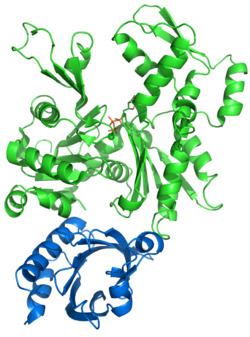Symbol Profilin InterPro IPR002097 PROSITE PS00414 | Pfam PF00235 SMART PROF SCOP 2btf | |
 | ||
Profilin
Profilin is an actin-binding protein involved in the dynamic turnover and restructuring of the actin cytoskeleton. It is found in all eukaryotic organisms in most cells. Profilin is important for spatially and temporally controlled growth of actin microfilaments, which is an essential process in cellular locomotion and cell shape changes. This restructuring of the actin cytoskeleton is essential for processes such as organ development, wound healing, and the hunting down of infectious intruders by cells of the immune system.
Contents
- Profilin
- Gene music quartet using protein sequence of pfn1 profilin 1
- Profilin in the regulation of actin dynamics
- History of profilin discovery
- Genes
- References
Profilin also binds sequences rich in the amino acid proline in diverse proteins. While most profilin in the cell is bound to actin, profilins have over 50 different binding partners. Many of those are related to actin regulation, but profilin also seems to be involved in activities in the nucleus such as mRNA splicing.
Profilin binds some variants of membrane phospholipids (Phosphatidylinositol (4,5)-bisphosphate and Inositol triphosphate). The function of this interaction is the sequestration of profilin in an "inactive" form, from where it can be released by action of the enzyme phospholipase C.
Profilin is the major allergen present in birch, grass, and other pollen and is found in Toxoplasma gondii as an essential part of host cell invasion. It is the specific PAMP of TLR11.
Gene music quartet using protein sequence of pfn1 profilin 1
Profilin in the regulation of actin dynamics
Profilin enhances actin growth in two ways:
Profilin also negatively regulates PI(3,4)P2 limiting recruitment of lamellipodin to the leading edge of the cell
Profilin is one of the most abundant actin monomer binders, but proteins such as CAP and (in mammals) thymosin β4 have some functional overlaps with profilin. In contrast, ADF/cofilin has some properties that antagonize profilin action.
History of profilin discovery
Profilin was first described by Uno Lindberg and co-workers in the early 1970s as the first actin monomer binding protein. It followed the realization that not only muscle, but also non-muscle cells, contained high concentrations of actin, albeit in part in an unpolymerized form. Profilin was then believed to sequester actin monomers (keep them in a pro-filamentous form), and release them upon a signal to make them accessible for fast actin polymer growth.
